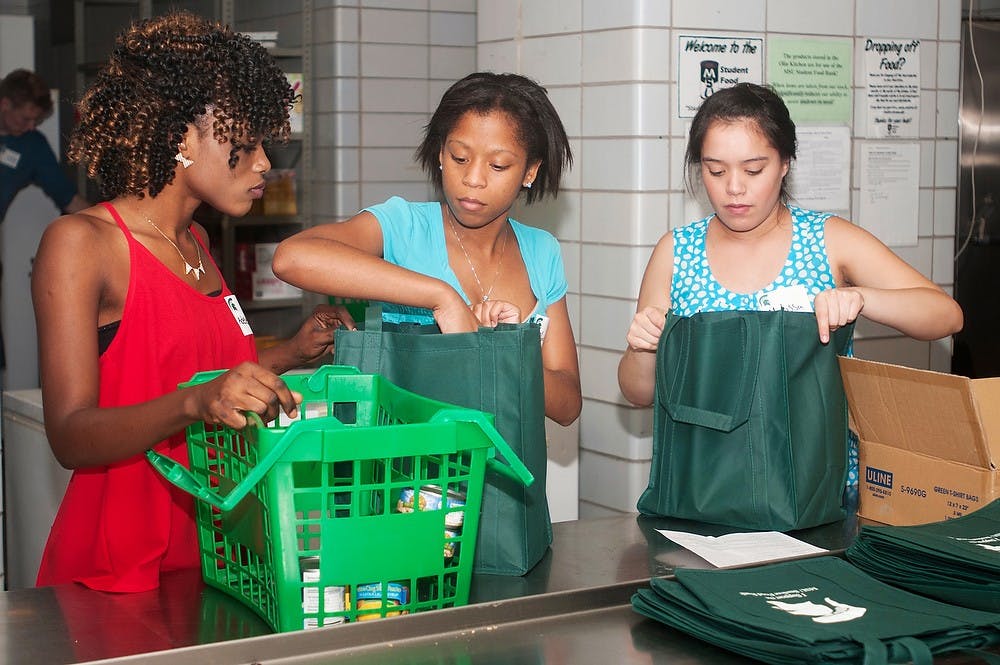Two hours and 17 minutes — that’s how long it takes to walk from Shaw Hall to LMTS Community Outreach Services, one of the Lansing area food pantries.
To walk to the Eastside Community Action Agency, a student living in Shaw would need to carve out one hour and 13 minutes. It would take 53 minutes to walk to the Haslett Community Food Bank.
A walk from Shaw Hall to Olin Health Center, where the MSU Student Food Bank is housed, takes about 13 minutes — but research suggests that more resources are needed for food insecure students.
The “Hunger on Campus” report put out by the College and University Food Bank Alliance, CUFBA, which was broken down in a previous State News article, found 48 percent of students nationally experienced food insecurity in the past month.
The report defines “very low food security” as significant decreases in quantity, quality and variety of food, along with disruptions in eating patterns because of inadequate access to food.
“I’m a single mom and so finances are definitely tough,” graduate student Trixi Beeker said. “I’m proud to be able to say that my son has never been short on food, but I definitely make some choices sometimes. Every week I make him lunch and the next day, whatever he hasn’t eaten in his lunch, I have for lunch. I do all kinds of things to cut corners.”
MSU trustee Dianne Byrum said she’s proud of the resources MSU already has available for food insecure students.
“There’s always more that can be done, but there are services for students," she said. "The food bank is a great example. The trustees put aside a certain percent of university-sponsored, need-based scholarships, and that’s something that we’ve always had as a priority.”
Although having an on-campus food pantry is an important first step, the MSU Student Food Bank doesn’t have the capacity to provide everything every food insecure student needs.
The MSU Student Food Bank works to “cut the grocery bill at least in half,” according to a recent advertisement taken out by the MSU Student Food Bank to call for holiday donations.
Students who still can’t afford the other half of the grocery bill will have to travel to another area food bank, which can take hours, even by bus.
Most Lansing area food banks have limited hours, making it even more difficult.
Beeker comes to the MSU Student Food Bank on its distribution day, which occurs every two weeks, but sometimes it conflicts with her class schedule.
Beeker said distribution night, “It’s like Christmas every two weeks.”
Since food banks are limited in what they can provide for food insecure students, communities need to look beyond immediate solutions, Nicole Edmonds, director of the MSU Student Food Bank, said.
“We can address the reasons why our students are food insecure,” Edmonds said in a previous State News article.
The “Hunger on Campus” report recommends policy change.
“The majority of food insecure students are struggling to make ends meet despite working or reaching out for assistance,” the report reads. Seventy-five percent of food insecure students receive financial aid, but remain food insecure.
Programs like MSU’s Student Emergency Assistance Fund, which provides emergency money to students who can’t make rent payments or pay for their classes, are an important tool, according to the report.
Lowering the cost of tuition is a better way to help food insecure students, CUFBA co-founder Nate Smith-Tyge said in a previous State News article.
“If we can find a way to keep tuition more in check, we can find a way to not have to have food programs because people will have enough income to be able to afford food.”
Beeker agrees.
“Tuition is insanely expensive,” she said. “It’s so much harder for (people who struggle financially) to get into school, and stay in school, and do well and study. A lot of them have to work at the same time.”
Byrum said it’s too early to know if tuition will be raised for the eighth-straight year, since the university doesn’t know what the state appropriation will be yet.
“That’s a conversation that we haven’t started yet,” she said. “Decisions around tuition are, I believe, the most difficult vote that a trustee makes and they’re taken very seriously.”
Although the “Hunger on Campus” report suggests that students need more assistance than they currently receive, the MSU Student Food Bank is an important resource.
“The food bank is a lifesaver, literally,” Beeker said. “Coming here I see all these other people and so I know I’m not alone in struggling, and that helps, too.”


